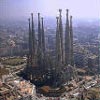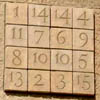The Sagrada Família magic square
The Spanish architect Antoni Gaudí (1852-1926); proposed that the Sagrada Família cathedral would take 200 years to complete. He devoted 43 years of his life to it before being killed by a streetcar.After a fire in 1936 that damaged the crypt and Gaudi's workshop, work on the façade of the passion restarted in 1952, based on the few original plans and models that survived the fire, and the four spires were completed between 1954 and 1976. In 1987 Catalan sculptor Josep María Subirachs joined the project, adding his controversial sculptures. Behind these figures is a magic square that appears to be his own design.
In squares of order 4 where the numbers run sequentially from 1-16 the magic constant (the sum of a single line, row or diagonal) is 34, but Subirachs' square does not contain the numbers 12 or 16 (see image, above). Instead, 10 and 14 are included twice, making a magic constant of 33, the age of Jesus Christ at the crucifixion.
There is a page exploring Subirachs' magic square in detail on the www.digitalquixote.com website, with an animated image displaying the various symmetrical combinations that also add to 33.
References
Gaudí, Antoni. Official commemorative site (English version). Commemoration of the 150th Anniversary of the Birth of Antoni Gaudí.
Wuerschinger, Stefan. Life and works of Antoni Gaudí. www.antonigaudi.net.
Subirachs, J. M. personal website of the sculptor. www.subirachs.org.
Image credits (from left to right - click image for referring/source page)
Aerial view of Sagrada Familia: unknown, from Google image search, original page fails to load.
Subirachs square close-up: Mathematics Education web site, Staffordshire Learning Net.
Sagrada Familia at night: http://lili.butterfly.free.fr/ole/gaudi.htm.


